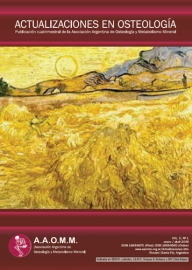OSTEOCYTE DEATH: A BEACON FOR TARGETED REMODELING
Contenido principal del artículo
Resumen
It has been long proposed that the osteocyte network continually compares present mechanical strains to usual levels of strain, and triggers signals to osteoclasts or osteoblasts resulting in bone loss or gain, as needed. Whereas physiological levels of mechanical stimulation maintain bone mass, too low or too high levels of strain induce bone resorption. One mechanism by which osteocytes may trigger bone resorption is by undergoing apoptosis. Either low or high levels of mechanical loading lead to increased prevalence of osteocyte apoptosis, which temporally precedes and is spatially associated with osteoclast recruitment and the subsequent increase in bone resorption.1,2 Moreover, a cause and effect relationship between osteocyte death and bone resorption has been recently demonstrated. Using a transgenic mouse model of inducible osteocyte ablation, Tatsumi et al.3 show that osteocyte apoptosis is sufficient to trigger osteoclast recruitment and bone resorption. Moreover, the normal osteoclastogenic response to unloading is missing in bones from osteocyte-depleted mice, confirming that osteocytes are indispensable for the skeletal adaptation to weightlessness. Because osteocyte apoptosis is inhibited not only by mechanical stimulation but also by estrogens and bisphosphonates, these findings raise the intriguing possibility that preservation of osteocyte viability contributes to the anti-remodeling properties of these agents.
Detalles del artículo
Derechos de autor: Actualizaciones en Osteología es la revista oficial de la Asociación Argentina de Osteología y Metabolismo Mineral (AAOMM) que posee los derechos de autor de todo el material publicado en dicha revista.

